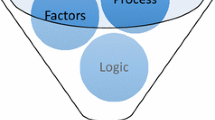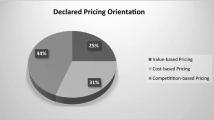Abstract
In industrial sales providers often neglect the potential for revenues in the customer’s usage processes after the actual transaction. However, innovative providers tend to shift revenues to the usage phase by setting prices according to actual service usage. In this article, we discuss the consequences of usage-based pricing in a twofold manner: First, we point out the potentials of usage-based pricing. Here, we show the additional value proposition when usage-based costs and risks are shifted from customers to providers as well as the opportunities and challenges of adopting that pricing scheme. Second, we analyze the profit impact of a usage-based pricing scheme in comparison with posted-price selling. The findings show that usage-based pricing can help discriminate customers by their usage intensity. With low usage-independent costs, usage-based pricing is more profitable than posted-price selling, even though providers must cover usage-based costs with that pricing scheme. With high usage-independent costs, providers should consider a minimum usage level or improve their advantage over customers in terms of usage-based costs.





Similar content being viewed by others
References
Anderson, J.C. and Narus, J.A. (1998) Business marketing: Understand what customers value. Harvard Business Review 76 (6): 53–65.
Bala, R. (2012) Pricing online subscription services under competition. Journal of Revenue and Pricing Management 11 (3): 258–273.
Bala, R. and Carr, S. (2010) Usage-based pricing of software services under competition. Journal of Revenue and Pricing Management 9 (3): 204–216.
Baron, O., Beyer, D. and Bitran, G.R. (2005) Pricing of shared computer services. Journal of Revenue and Pricing Management 4 (1): 54–65.
Bertini, M. and Gourville, J.T. (2012) Pricing to create shared value. Harvard Business Review 90 (6): 96–104.
Bonnemeier, S., Burianek, F. and Reichwald, R. (2010) Revenue models for integrated customer solutions: Concept and organizational implementation. Journal of Revenue and Pricing Management 9 (3): 228–238.
Bowman, C. and Ambrosini, V. (2000) Value creation versus value capture: Towards a coherent definition of value in strategy. British Journal of Management 11 (1): 1–15.
Brady, T., Davies, A. and Gann, D.M. (2005) Creating value by delivering integrated solutions. International Journal of Project Management 23 (5): 360–365.
Buse, C., Freiling, J. and Weissenfels, S. (2001) Turning product business into service business: Performance contracting as a challenge of SME customer/supplier networks. Paper presented at the 17th IMP-Conference, Oslo, http://impgroup.org/uploads/papers/157.pdf, accessed 13 November 2014.
Chao, Y. (2013) Strategic effects of three-part tariffs under oligopoly. International Economic Review 54 (3): 977–1015.
Choudhary, V. (2007) Comparison of software quality under perpetual licensing and software as a service. Journal of Management Information Systems 24 (2): 141–165.
Davies, A., Brady, T. and Hobday, M. (2006) Charting a path toward integrated solutions. MIT Sloan Management Review 47 (3): 39–48.
Decker, C. and Paesler, S. (2004) Financing of Pay-on-Production-Models. In: A. Knorr, A. Lemper, A. Sell and K. Wohlmuth (eds.) Proceedings of the World Economics Colloquium; No. 92, Germany, Bremen: Institute for World Economics and International Management.
Dutta, S., Zbaracki, M.J. and Bergen, M. (2003) Pricing process as a capability: A resource-based perspective. Strategic Management Journal 24 (7): 615–630.
Essegaier, S., Gupta, S. and Zhang, Z.J. (2002) Pricing access services. Marketing Science 21 (2): 139–159.
Evanschitzky, H., Wangenheim, F.V. and Woisetschläger, D.M. (2011) Service & solution innovation: Overview and research agenda. Industrial Marketing Management 40 (5): 657–660.
Farres, R. (2012) Optimal pricing models in B2B organizations. Journal of Revenue and Pricing Management 11 (1): 35–39.
Fishburn, P.C. and Odlyzko, A.M. (1999) Competitive pricing of information goods: Subscription pricing versus pay-per-use. Economic Theory 13 (2): 447–470.
Fjell, K. (2010) Online advertising: Pay-per-view versus pay-per-click with market power. Journal of Revenue and Pricing Management 9 (3): 198–203.
Flint, D.J., Woodruff, R.B. and Gardial, S.F. (1997) Customer value change in industrial marketing relationships: A call for new strategies and research. Industrial Marketing Management 26 (2): 163–175.
Galbraith, J.R. (2002) Organizing to deliver solutions. Organizational Dynamics 31 (2): 194–207.
Gale, B.T. and Swire, D.J. (2012) Implementing strategic B2B pricing: Constructing value benchmarks. Journal of Revenue and Pricing Management 11 (1): 40–53.
Grönroos, C. and Helle, P. (2010) Adopting a service logic in manufacturing: Conceptual foundation and metrics for mutual value creation. Journal of Service Management 21 (5): 564–590.
Gurnani, H. and Karlapalem, K. (2001) Optimal pricing strategies for Internet-based software dissemination. Journal of the Operational Research Society 52 (1): 64–70.
Hinterhuber, A. (2004) Towards value-based pricing – An integrative framework for decision making. Industrial Marketing Management 33 (8): 765–778.
Hinterhuber, A. (2008) Customer value-based pricing strategies: Why companies resist. Journal of Business Strategy 29 (4): 41–50.
Hinterhuber, A. and Liozu, S.M. (2012) Strategic B2B pricing. Journal of Revenue and Pricing Management 11 (1): 1–3.
Hünerberg, R. and Hüttmann, A. (2003) Performance as a basis for price-setting in the capital goods industry: Concepts and empirical evidence. European Management Journal 21 (6): 717–730.
Hypko, P., Tilebein, M. and Gleich, R. (2010) Benefits and uncertainties of performance-based contracting in manufacturing industries: An agency theory perspective. Journal of Service Management 21 (4): 460–489.
Jensen, S. (2006) Implementation of competitive nonlinear pricing: Tariffs with inclusive consumption. Review of Economic Design 10 (1): 9–29.
Kujala, S., Artto, K., Aaltonen, P. and Turkulainen, V. (2010) Business models in project-based firms – Towards a typology of solution-specific business models. International Journal of Project Management 28 (2): 96–106.
Lambrecht, A., Seim, K. and Skiera, B. (2007) Does uncertainty matter? Consumer behavior under three-part tariffs. Marketing Science 26 (5): 698–710.
Lay, G., Schroeter, M. and Biege, S. (2009) Service-based business concepts: A typology for business-to-business markets. European Management Journal 27 (6): 442–455.
Liozu, S.M., Hinterhuber, A. and Somers, T. (2014) Organizational design and pricing capabilities for superior firm performance. Management Decision 52 (1): 54–78.
Nagle, T.T. and Holden, R.K. (2002) The Strategy and Tactics of Pricing: A Guide to Profitable Decision Making. Upper Saddle River, NJ: Prentice Hall.
Ng, I.C.L. (2010) Special issue on pricing and revenue models in the new service economy. Journal of Revenue and Pricing Management 9 (3): 195–197.
Ng, I.C.L., Maull, R. and Yip, N. (2009) Outcome-based contracts as a driver for systems thinking and service-dominant logic in service science: Evidence from the defence industry. European Management Journal 27 (6): 377–387.
Ng, I.C.L., Parry, G., Smith, L., Maull, R. and Briscoe, G. (2012) Transitioning from a goods-dominant to a service-dominant logic: Visualising the value proposition of Rolls-Royce. Journal of Service Management 23 (3): 416–439.
Oliva, R. and Kallenberg, R. (2003) Managing the transition from products to services. International Journal of Service Industry Management 14 (2): 160–172.
Postmus, D., Wijngaard, J. and Wortmann, H. (2009) An economic model to compare the profitability of pay-per-use and fixed-fee licensing. Information and Software Technology 51 (3): 581–588.
Sawhney, M. (2006) Going beyond the product, defining, designing, and delivering customer solutions. In: R.F. Lusch and S.L. Vargo (eds.) The Service-Dominant Logic of Marketing: Dialog, Debate, and Directions. Armonk, NY: M.E. Sharpe, pp. 365–380.
Schlereth, C. and Skiera, B. (2012) Measurement of consumer preferences for bucket pricing plans with different service attributes. International Journal of Research in Marketing 29 (2): 167–180.
Snelgrove, T. (2012) Value pricing when you understand your customers: Total cost of ownership – Past, present and future. Journal of Revenue and Pricing Management 11 (1): 76–80.
Storbacka, K. (2011) A solution business model: Capabilities and management practices for integrated solutions. Industrial Marketing Management 40 (5): 699–711.
Terho, H., Haas, A., Eggert, A. and Ulaga, W. (2012) ‘It’s almost like taking the sales out of selling’ – Towards a conceptualization of value-based selling in business markets. Industrial Marketing Management 41 (1): 174–185.
Thiesse, F. and Köhler, M. (2008) An analysis of usage-based pricing policies for smart products. Electronic Markets 18 (3): 232–241.
Toffel, M.W. (2008) Contracting for Servicizing. Boston, MA: Harvard Business School. Working Paper No. 08-063.
Töllner, A., Blut, M. and Holzmüller, H.H. (2011) Customer solutions in the capital goods industry: Examining the impact of the buying center. Industrial Marketing Management 40 (5): 712–722.
Tuli, K.R., Kohli, A.K. and Bharadwaj, S.G. (2007) Rethinking customer solutions: From product bundles to relational processes. Journal of Marketing 71 (3): 1–17.
Ulaga, W. and Chacour, S. (2001) Measuring customer-perceived value in business markets. Industrial Marketing Management 30 (6): 525–540.
Ulaga, W. and Reinartz, W.J. (2011) Hybrid offerings: How manufacturing firms combine goods and services successfully. Journal of Marketing 75 (6): 5–23.
Wise, R. and Baumgartner, P. (1999) Go downstream: The new profit imperative in manufacturing. Harvard Business Review 77 (5): 133–141.
Woodruff, R.B. and Flint, D.J. (2006) Marketing’s service-dominant logic and customer value. In: R.F. Lusch and S.L. Vargo (eds.) The Service-Dominant Logic of Marketing: Dialog, Debate, and Directions. Armonk, NY: M.E. Sharpe, pp. 183–195.
Zhang, J. and Seidmann, A. (2010) Perpetual versus subscription licensing under quality uncertainty and network externality effects. Journal of Management Information Systems 27 (1): 39–68.
Author information
Authors and Affiliations
Corresponding author
Rights and permissions
About this article
Cite this article
Stoppel, E., Roth, S. Consequences of usage-based pricing in industrial markets. J Revenue Pricing Manag 14, 140–154 (2015). https://doi.org/10.1057/rpm.2015.6
Received:
Revised:
Published:
Issue Date:
DOI: https://doi.org/10.1057/rpm.2015.6




